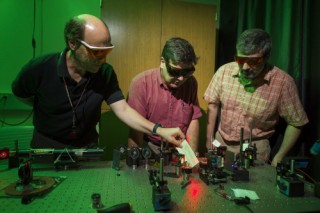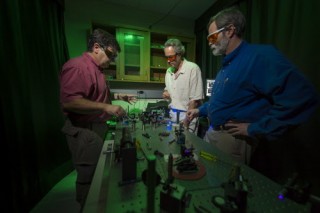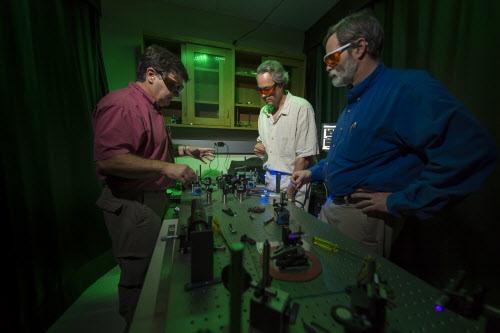
Professor Galvez’s photon quantum mechanics lab is transforming physics education.
While physicists consider the century-old theory of quantum mechanics to be the most successful physical theory ever invented, they have spent the past several decades figuring out the best way to teach it.
Colgate’s Professor Enrique “Kiko” Galvez is at the forefront of a paradigm shift in the way quantum mechanics is taught.
Starting with a grant from the National Science Foundation in 1999, Charles Holbrow, Emeritus Professor, and Galvez embarked in project that seemed far fetched and bold.
Advancing technology and a sound type of physics experiment led them to undergraduate-level demonstrations that only a decade earlier were stunning research discoveries. “By 2005 we had not only satisfied our wildest expectations, but we started disseminating and designing prototypes so others could adopt.”
Talks at national and international conferences gave way to workshops, and to a current state, where faculty from some of the nation’s leading research universities come yearly to Colgate to the labs at the Robert H.N. Ho Interdisciplinary Science Center, to learn to do the series of experiments he has created to illustrate the field’s most puzzling aspects.
For the lay person, Galvez explained it this way: “The predictions of quantum mechanics rely on philosophically troubling precepts, such as ‘superposition,’ where, taken to an extreme case, objects can be traveling through two separate openings at the same time.
“Another example,” he explained, “is ‘realism,’ where the physical reality of an object can be undefined, meaning an object can be two distinct things at once.
“And then there’s ‘nonlocality,’ where two objects can be so intrinsically linked, or `entangled,’ that doing something to one affects the other instantly, regardless of where it is — literally.”
Until Galvez created his experiments, these predictions and others were considered as merely philosophical issues, not practical for classroom instruction in physics.
“Quantum mechanics everywhere was taught in a mechanistic sense,” Galvez said. “That is, using the mathematics and predictive power of the theory, but ignoring its philosophical consequences.”
So he set out to find a new way to get undergraduate students excited about experimentation, and let them discover in the laboratory the abstractions of quantum mechanics.

Creating physical proof
“What we did at Colgate was to create a series of experiments that demonstrate that these fundamental aspects of quantum mechanics are true. We see them in action right before our eyes — although not literally, as the light is too weak for our eyes to see them. But at least they are within an arm’s length! We use light, which in the quantum world, it is made of photons. So we call them `photon quantum mechanics laboratories.’”
Other aspects of Galvez’s lab are a model of undergraduate research. And his involvement of undergraduates in top-level research earned him the American Physical Society’s prestigious Prize for a Faculty Member for Research in an Undergraduate Institution in 2010.
The most recent workshop took place at Colgate in August, welcoming professors from Haverford College, the University of San Diego, and elsewhere. It was sponsored by the “Advanced Lab Physics Association” and funded by the National Science Foundation.
With curricular reform that involved Colgate faculty members Joe Amato and Beth Parks, Colgate students taking the first-semester physics course get a unique experience: an exposure to quantum mechanics with a lab on superposition. At the upper-level the curriculum is more daring: “Colgate is only one of two schools in the country that has an actual laboratory section for Quantum Mechanics.”
“Everywhere else, it’s just a theory course.”
